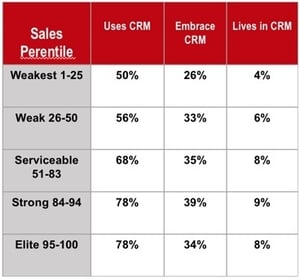
Sales Playbook and CRM Problems - What the Data Tells Us
I can't remember a spring where the pollen was worse than in 2018. You go to the car wash and an hour later your beautiful car is covered in yellow crud and you're out $20. A waste.
Perhaps you have an irrigation system with a rain sensor that tells the controller that your lawn and flower beds don't need to be watered today because it is pouring outside. Yet, when you look out the window you see that the sprinklers are running despite the existence of a rain sensor. A waste.
Did you ever spend hours assembling a child's toy only to watch it sit unused until the kid outgrew it and you gave it away? Waste.
For years I noticed that most people never touched the manuals, handouts, CD's, card decks, and books that were distributed to them for the training programs in which they participated. How many books, studies, manuals and reports have you received that sat and collected dust, reside on your hard drive or in the cloud and remain unopened to this day? In my office, I have 6 shelves full of books that I never read and probably won't read half of the books on my Kindle either! Waste.
That leads me to the growing demand for Sales Playbooks. Companies want them, get excited about them, believe they are important, pay tens of thousands of dollars for them, and invest many hours collaborating for a successful final document. You won't believe the wasteful things that happen next!
Over the past several years, I have witnessed two Sales Playbook creation scenarios repeatedly play out.
The executives who are most adamant about wanting to collaborate engage early but then fail to invest the time and effort necessary to provide the data, sample reports, knowledge, expectations, metrics and other information required to create a powerful and useful playbook. They lose interest and without the necessary company-specific information, they end up with a playbook that is more generic so they don't bother to distribute the book to their salespeople.
Collaboration takes place as expected, a great playbook is created, and after distributing it to their salespeople, the books are never again opened or referenced.
In my experience, there is a sense that as long as the company issues a check to pay for the creation of the playbook, they can check the box and move on to their next project. Check for a check. They believe that getting the project started is more important than getting the project finished, seeing it through and assuring that the book is utilized according to expectations. Waste.
I am a big fan of Membrain, the sales enablement application that manages pipeline with a focus on sales process and opportunities with integrated CRM. Not only do they have a version with Baseline Selling built in, their interface is designed specifically for the creation of playbooks within the sales process. Each milestone can be a separate playbook, with drop-downs, calculations, conditions, if-thens, cause and effect, instructions, examples and more.
Why invest in a stand alone playbook that either won't be completed or won't be used when there is such a terrific sales enablement application that allows you to integrate all of the desired components in one place?
I will no longer invest time to collaborate with senior executives to compile playbooks when Membrain is a significantly better alternative. I am happy to help companies integrate playbook and sales process within an application like Membrain. Salespeople that live in Membrain are more able to drive their opportunities forward and manage their pipelines.

The biggest challenge with CRM/Opportunity/Pipeline Management applications is that most salespeople hate them and resist using them. Want proof? Objective Management Group (OMG) measures 21 Sales Core Competencies and one of them is CRM Savvy. Look at the data below from a subset totaling 450,000 salespeople that were evaluated in the past 5 years.
The data, showing 3 attributes of the CRM Savvy competency, clearly shows that while the majority of salespeople use CRM, stronger salespeople are 56% more likely to use it than weaker salespeople. Fewer than 40% of salespeople embrace CRM and fewer than 10% actually live in their CRM application. Living in CRM is a best practice so what does that tell you? It means that if your salespeople aren't choosing to live in your CRM application, you chose the wrong freaking CRM application!

By Dave Kurlan
Dave Kurlan is a top-rated speaker, best-selling author, successful entrepreneur, and sales development industry pioneer. Dave also founded Objective Management Group, the leading developer of sales assessment tools, and works as the CEO of Kurlan & Associates, a leading salesforce development firm that he started in 1985. He has 3 decades of experience in all facets of sales development, including consulting, training, coaching, selection, strategy, systems, processes, and metrics.
Dave is also the creator of the Membrain Baseline Selling Edition, a pre-configured Membrain with Baseline Selling built-in, including Dave's sales enablement content. This Edition will help your salespeople to make your way of selling into a competitive advantage.
Find out more about Dave Kurlan on LinkedIn







